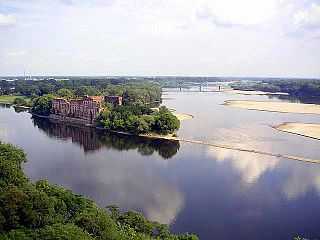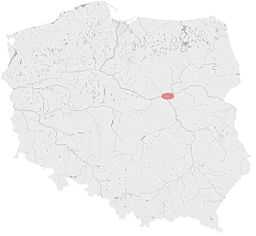Bugonarew
| Bugonarew | |
| River | |
 | |
| Country | Poland |
|---|---|
| Counties | Legionowo, Nowy Dwór Mazowiecki |
| Tributaries | |
| - left | Rządza |
| - right | Wkra |
| Towns/Cities | Serock, Nieporęt, Topolina, Stare Orzechowo, Nowy Dwór Mazowiecki |
| Source | |
| - location | Zegrze Reservoir, Poland |
| - elevation | 79 m (259 ft) |
| - coordinates | 52°30′35.83″N 21°5′10.31″E / 52.5099528°N 21.0861972°E |
| Mouth | |
| - location | Nowy Dwór Mazowiecki, Mazovia, Poland |
| - elevation | 70.7 m (232 ft) |
| - coordinates | 52°26′N 20°41′E / 52.433°N 20.683°ECoordinates: 52°26′N 20°41′E / 52.433°N 20.683°E |
| Length | 24 km (15 mi) |
| Discharge | for Nowy Dwór Mazowiecki |
| - average | 328 m3/s (11,583 cu ft/s) |
| colspan="2" style=""text-align: left"" | Discharge elsewhere (average) | |
| - entering Pułtusk | 146 m3/s (5,156 cu ft/s) |
 | |
Bugonarew (or Bugo-Narew; the name being a combination of the names of Bug and Narew rivers) is a former name of the lowest course of the Narew river in Poland. It originates from the waters of Bug and Narew rivers in the artificial Zegrze Reservoir and flows into Vistula at Modlin.
Until after World War II rivers were commonly classified by their length. As at the confluence near Zegrze Bug is longer than Narew, the Bugonarew was often considered part of Bug river and Narew was thought of as its tributary. However, at the same time Narew's discharge is much higher at their meeting point. Because of that the river was variously referred to as either Narew, Bug, Bugo-Narew, Bugonarew, Narwiobug or Narwobug.
As there was no official stance on which of the two rivers is tributary of the other, in official Polish documents both were considered to be tributaries of "Bugonarew", which in turn was a right tributary of the Vistula. However, as the laws changed, on December 27, 1962 the Prime Minister of Poland's act abolished the name soon after the Zegrze Reservoir had been constructed.[1] Since then the river is considered to be part of Narew, while Bug is nowadays considered its left tributary.
The name however is continued to be used, especially by the inhabitants of towns located along the banks of the river, such as Pułtusk.
References
- ↑ (Polish) "Monitor Polski" 1963, nr 3, poz. 6
See also
- Bug
- Narew
- Rivers of Poland
- Geography of Poland